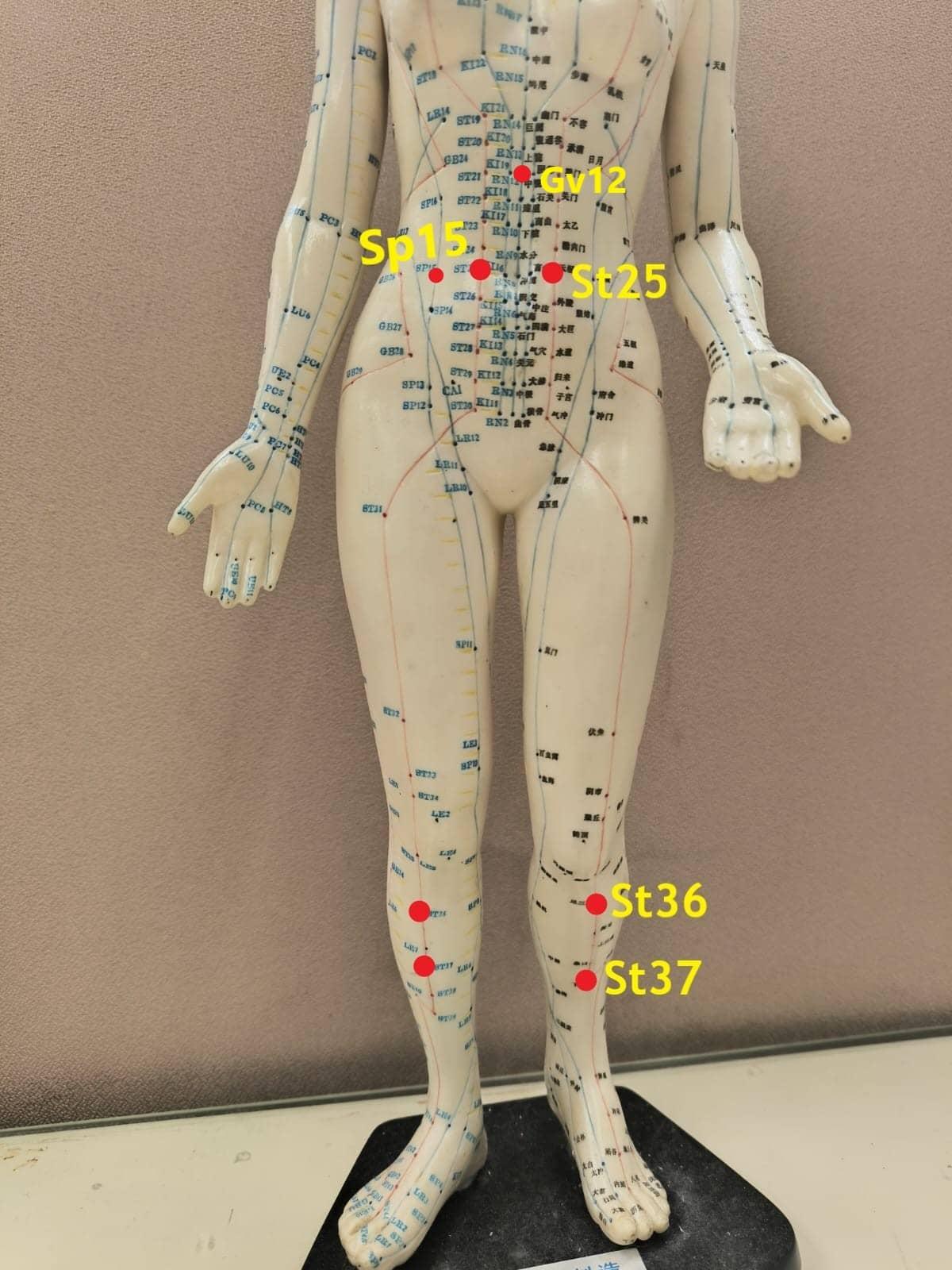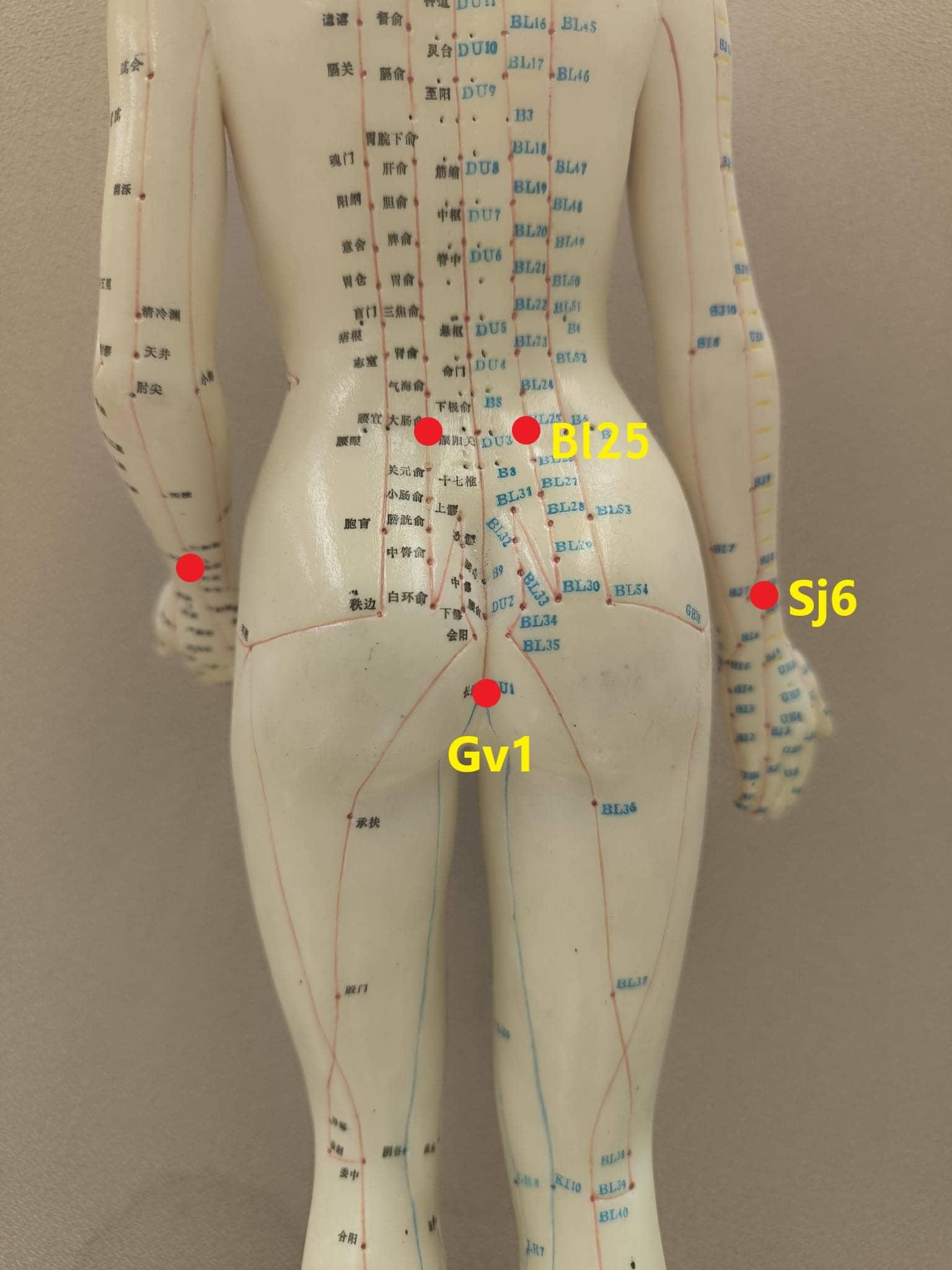Acupoint therapy is a collection of therapeutic techniques derived from Traditional Chinese Medicine (TCM). It involves stimulating specific body points to promote healing and well-being. The common acupoints that used for constipation include da chang shu (Bl25), tian shu (St25), zhi gou (Sj6), chang qiang (Gv1), zu san li (St36), & shang ju xu (St37).
Acupuncture therapy involves inserting thin needles into acupoints on the body surface, which aim to smooth qi flowing through pathways called
meridians. Acupuncture can regulate digestive processes, enhance bowel movements, and relieve abdominal discomforts.
Acupuncture prescriptions for constipation
1. Feng long (St40),
shui dao (St28, left side only),
gui lai (St29, right side only), also two extra points (2-inch apart from the left St28, and 2-inch apart from the right St29). During needling, apply
lifting and thrusting techniques for one minute, and then the needles are left in place for 30 minutes. Perform once a day.
2. Major point selections include da chang shu (Bl25), tian shu (St25), zhi gou (Sj6), shang ju xu (St37); assistant points are selected according to individual conditions, for example:
- Abdominal distention or pain: zhong wan (Cv12) and zu san li (St36).
- Deficient pattern: pi shu (Bl20), wei shu (Bl21), qi hai (Cv6) or fei shu (Bl13), the points are applied with moxa heating after needling.
- Cold pattern: ming men (Gv4), qi hai (Cv6) or guan yuan (Cv4), the points are applied with moxa heating only.
The applying method:
- Apply transcutaneous needling on the St25: insert a needle on St25, make the needle tip pass through the subcutaneous tissues and towards another point, da heng (Sp15), there should be bowel sounds appearing during the procedure. This way of stimulation can regulate both the stomach meridian and spleen meridian, enhancing the treatment effects on digestive problems. After needling on the St25, cupping on it additionally.
- For the other points, insert a needle on each point, try to achieve the needling sensation, then leave the needles in place for 20 to 30 minutes.
Perform daily, and 10 sessions as a course of treatment.
3. Point selections include
da zhui (Gv14),
qu chi (Li11),
shui dao (St28, left side only),
gui lai (St29, right side only),
feng long (St40),
he gu (Li4). After inserting the needles, apply lifting and thrusting techniques for one minute on each acupoint to achieve the
needling sensation; small electrodes are then attached to the needles, adjusting the device to deliver a medium level of electrical stimulation for 15 to 30 minutes. Perform daily, and 10 sessions as a course of treatment.
An acupuncture protocol for heat pattern constipation
A 33-year-old female patient has constipation for 6 years; she needs laxatives for relief occasionally. Her condition has aggravated lately, that the bowels only once a week, oral laxatives are not helpful. Besides constipation, she has weight gain, bad breath, a bitter taste in mouth and abdominal bloating. Her
tongue is red with a yellow coating, and the
pulse is taut. Physician diagnosed her constipation as excess heat accumulated in the intestines.
Therapeutic principle: purge heat and empty bowel.
Acupoint selection: zhong wan (Cv12), da heng (Sp15), tian shu (St25), zhi gou (Sj6), & cheng shan (Bl57).
Applying method: keep a lying position, disinfect the local area, and then insert a 40 or 50 mm filiform needle vertically on each point, depending on the thickness of the patient's abdominal wall, the needle can be inserted to a depth of 25–35 mm. Apply
reducing techniques to achieve the needling sensation; needle retention for 30 minutes, meanwhile apply reducing techniques every 5 minutes. Perform daily, 10 sessions as a course of treatment.
Interpretation: Cv12 is the alarm point of the
stomach meridian which regulates gastrointestinal functions; St25 is the
alarm point of the
large intestine meridian which smooths
qi movements inside the large intestine and promotes bowel movements; Sp15 belongs to the
spleen meridian that regulates bowel movements; Sj6 stimulates qi movements in the
triple burner which benefits intestinal content travelling; Bl57 is specially for bowel difficulty due to anal problems.
For individuals with constipation, acupoints are typically selected on the abdominal region. However, the abdominal wall only consists of several thin layers of muscles, so precautions are necessary. It is important to fully understand your health needs and perform acupuncture under the guidance of a professional physician, this can ensure safety as well as get optimal results.
Before acupuncture therapy, avoid being overly full, hungry, extremely fatigued, or emotionally agitated. After the therapy, do not rub the needling points, avoid vigorous exercise, and immediate contact with water. It is also advised to closely monitor any adverse effect like bruising or swelling.




